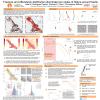Poster #160, Fault and Rupture Mechanics (FARM)
Dynamic rupture modeling of coseismic interactions on orthogonal strike-slip faults
Poster Image:

Poster Presentation
2020 SCEC Annual Meeting, Poster #160, SCEC Contribution #10678 VIEW PDF
led to the source faults rupturing in two closely-spaced earthquakes as opposed to one single larger event. That extends to broader questions about general behaviors of orthogonal strike-slip faults as earthquake gates: what conditions might make them rupture together versus separately, how likely is a rupture on one fault to activate a large cross-fault, and is this persistent behavior versus something changes over multiple earthquake cycles? Here, I use the 3D finite element method to simulate dynamic ruptures on orthogonal strike-slip fault systems with several geometrical configurations. In models with uniform initial stresses on both faults, which isolate the effects of fault geometry, I find that a stopping phase from rupture hitting the end of one fault is necessary to initiate rupture on the other. A rupture on one fault that crosses the other and continues on does not activate the second fault. I compare this set of models to ones in which the fault system is in a regional stress field, which produces different initial stresses on each fault.
SHOW MORE
SHOW MORE























































